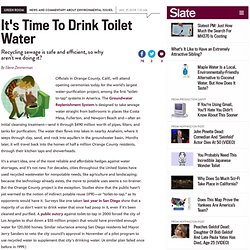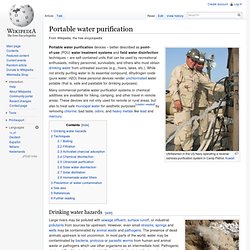

How toilet-to-tap programs could help preserve our water supply. Officials in Orange County, Calif., will attend opening ceremonies today for the world's largest water-purification project, among the first "toilet-to-tap" systems in America.

The Groundwater Replenishment System is designed to take sewage water straight from bathrooms in places like Costa Mesa, Fullerton, and Newport Beach and—after an initial cleansing treatment—send it through $490 million worth of pipes, filters, and tanks for purification. The water then flows into lakes in nearby Anaheim, where it seeps through clay, sand, and rock into aquifers in the groundwater basin. Months later, it will travel back into the homes of half a million Orange County residents, through their kitchen taps and showerheads.
Water purification. Control room and schematics of the water purification plant to Lac de Bret, Switzerland Water purification is the process of removing undesirable chemicals, biological contaminants, suspended solids and gases from contaminated water.

The goal of this process is to produce water fit for a specific purpose. Most water is disinfected for human consumption (drinking water) but water purification may also be designed for a variety of other purposes, including meeting the requirements of medical, pharmacological, chemical and industrial applications. In general the methods used include physical processes such as filtration, sedimentation, and distillation, biological processes such as slow sand filters or biologically active carbon, chemical processes such as flocculation and chlorination and the use of electromagnetic radiation such as ultraviolet light.
The standards for drinking water quality are typically set by governments or by international standards. Point-of-use water treatment. Utilitiesman in the US Navy operating a reverse osmosis purification system in Camp Patriot, Kuwait Portable water purification devices – better described as point-of-use (POU) water treatment systems and field water disinfection techniques – are self-contained units that can be used by recreational enthusiasts, military personnel, survivalists, and others who must obtain drinking water from untreated sources (e.g., rivers, lakes, etc.).

While not strictly purifing water to its essential compound, dihydrogen oxide (pure water, H2O) these personal devices render unchlorinated water potable (that is, safe and palatable for drinking purposes).
Www.nanoisrael.org/download/nanowater1/US-IL NanoWater Workshop Program Final 09-MAR.pdf.